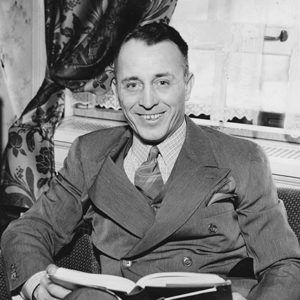calsfoundation@cals.org
John Harvey Sorrells (1896–1948)
John Harvey Sorrells was executive editor of the Scripps-Howard newspaper chain and former deputy director of the U.S. Office of Censorship during World War II. At the time of his death, the Pine Bluff (Jefferson County) native was well respected in journalism circles for his first-hand knowledge of the field and his warm, engaging personality.
John Harvey Sorrells was born on March 31, 1896, in a one-story house on State Street in Pine Bluff, one of four children of Walter Bartlett Sorrells, who was a circuit judge, and Mary Iva Fletcher Sorrells. In 1886, his maternal grandfather, Reid Fletcher, launched and edited the Daily Graphic newspaper in Pine Bluff. As a high school student working part time, John Sorrells would start his career in journalism at the paper (long after the family had sold it).
After Sorrells graduated from high school in Pine Bluff, where he was a star football player, he attended Washington and Lee University in Virginia in 1914. He left college after three years when the United States entered World War I. Sorrells spent the war training soldiers at Camp Pike near Little Rock (Pulaski County) as a first lieutenant. After he was discharged from the U.S. Army in late 1918, he returned to the Daily Graphic, becoming its editor at the age of twenty-five.
From 1923 to 1930, Sorrells progressed quickly through a series of media jobs that honed his expertise for newsgathering, editing and design, news promotion, and newspaper management. Starting in January 1923, he worked for the Oklahoman in Oklahoma City and eventually became its editor. In 1924, he returned to Pine Bluff to be editor of the Pine Bluff Commercial. He soon moved to the Fort Worth Record in Texas but then went back to the Oklahoman for a short time before returning to Pine Bluff to work briefly in the advertising department of the Arkansas Power and Light Company (AP&L).
By 1926, Sorrells was working for the Scripps-Howard chain, quickly becoming managing editor of the chain’s flagship Cleveland Press newspaper. In the fall of that year, he was asked to oversee the consolidation of the Scripps-owed Memphis Press newspaper with a competing local newspaper the chain had purchased. Serving as managing editor of the renamed Memphis Press-Scimitar, Sorrells received national attention when he had a photographer in an airplane take aerial shots of the 1927 Mississippi River Flood. He also used airplanes to deliver newspapers to areas in which people were trapped by floodwaters. In 1927, the chain appointed Sorrells editor of its Fort Worth Press newspaper.
In 1930, he published one of the first news-editing textbooks, The Working Press. In 1930, he was appointed as executive editor of all of the chain’s newspapers. Based in New York City, Sorrells was tasked with ensuring that the newsgathering and publishing operations of the chain attracted readers and made financial sense. However, his connection to Memphis, Tennessee, had by no means ended. In 1936, the chain again turned to Sorrells to determine ways to operate two Scripps-owned daily newspapers with distinct identities in Memphis after it acquired the Memphis Press-Scimitar’s morning rival, the Memphis Commercial Appeal. Sorrells later wrote that his many years of work as president of the Memphis Publishing Company, which operated Memphis radio and television properties and both daily newspapers as part of the Scripps chain, was his proudest career achievement.
Byron Price, director of the U.S. Office of Censorship during World War II, selected Sorrells as assistant director of press censorship in December 1941. Sorrells was promoted to deputy director of the entire office the following May. While at the Office of Censorship, Sorrells helped write the codes of voluntary conduct for print publications and radio broadcasters. He returned to Scripps-Howard in 1943 as its executive editor.
He wrote the chain’s first official corporate history, A Handbook of Scripps Howard, in 1948. By that year, the chain operated twenty dailies, making it one of the largest media companies in the country.
Sorrells died unexpectedly of a massive heart attack at age fifty-one on February 25, 1948, after spending an evening at home entertaining friends with his wife, Ruth Arnett Sorrells, also a Pine Bluff native. He was buried in Graceland Cemetery on February 28 after a funeral in Pine Bluff that was attended by family, friends, and a large number of Scripps executives. The Pine Bluff Commercial reported that five truckloads of flowers covered his grave.
John and Ruth Sorrells had four children. Their youngest child, Robert T. Sorrells, edited and published a book of his father’s writings in 2013.
For additional information:
“John H. Sorrells, Journalist, Dead.” New York Times, February 26, 1948, p. 23.
“John H. Sorrells, Native of Pine Bluff and Noted Newspaper Official, Dies.” Pine Bluff Commercial, February 25, 1948, p. 1.
Sorrells, John H. A Handbook of Scripps Howard. Cincinnati: E.W. Scripps Company, 1948.
———. The Working Press: Memos from the Editor about the Front and Other Pages. New York: The Ronald Press Company, 1930.
Sorrells, Robert T., ed. Killing Your Own Snakes: The Journalistic World of John H. Sorrells. Bloomington, IN: Xlibris, 2013.
Sweeney, Michael S. Secrets of Victory: The Office of Censorship and the American Press and Radio in World War II. Chapel Hill: University of North Carolina Press, 2001.
Dale E. Zacher
St. Cloud State University
 Early Twentieth Century, 1901 through 1940
Early Twentieth Century, 1901 through 1940 Literature and Authors
Literature and Authors Mass Media
Mass Media John Sorrells
John Sorrells  John Sorrells
John Sorrells 




Comments
No comments on this entry yet.